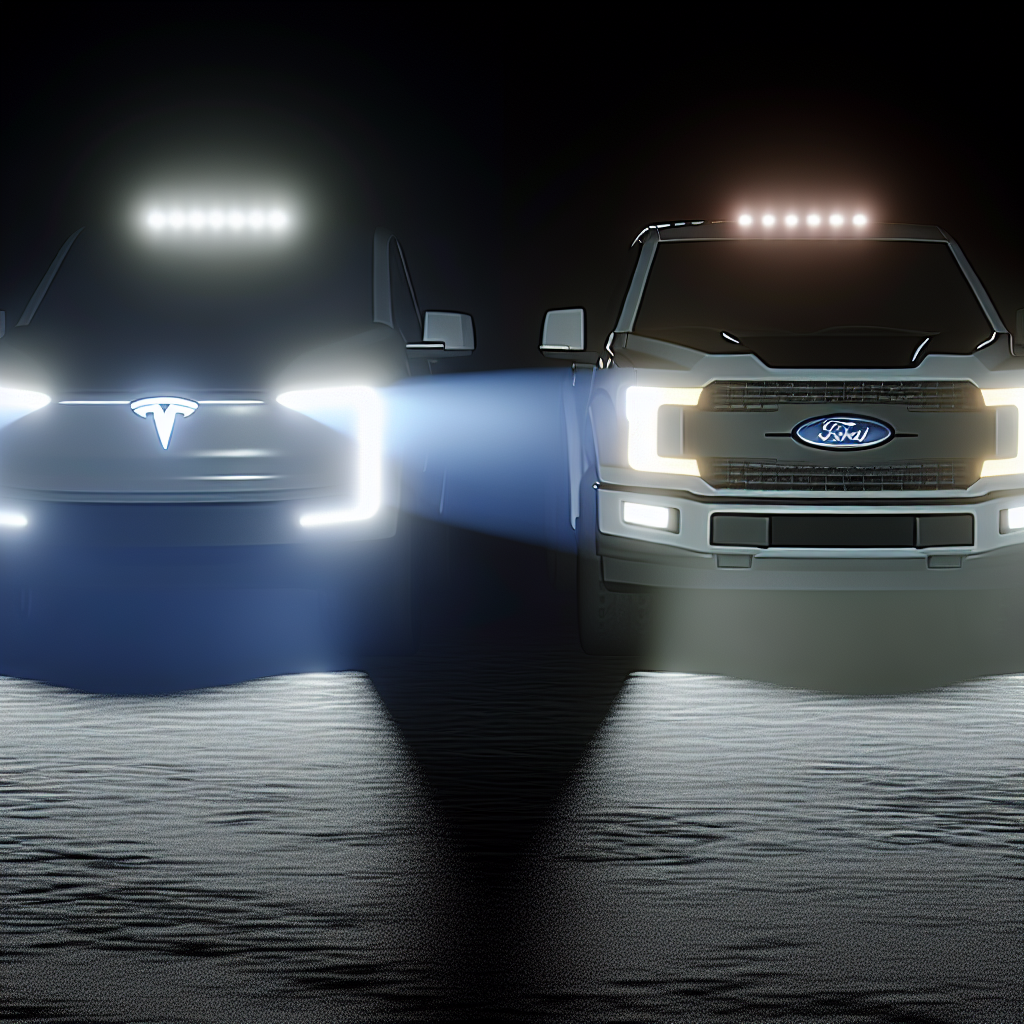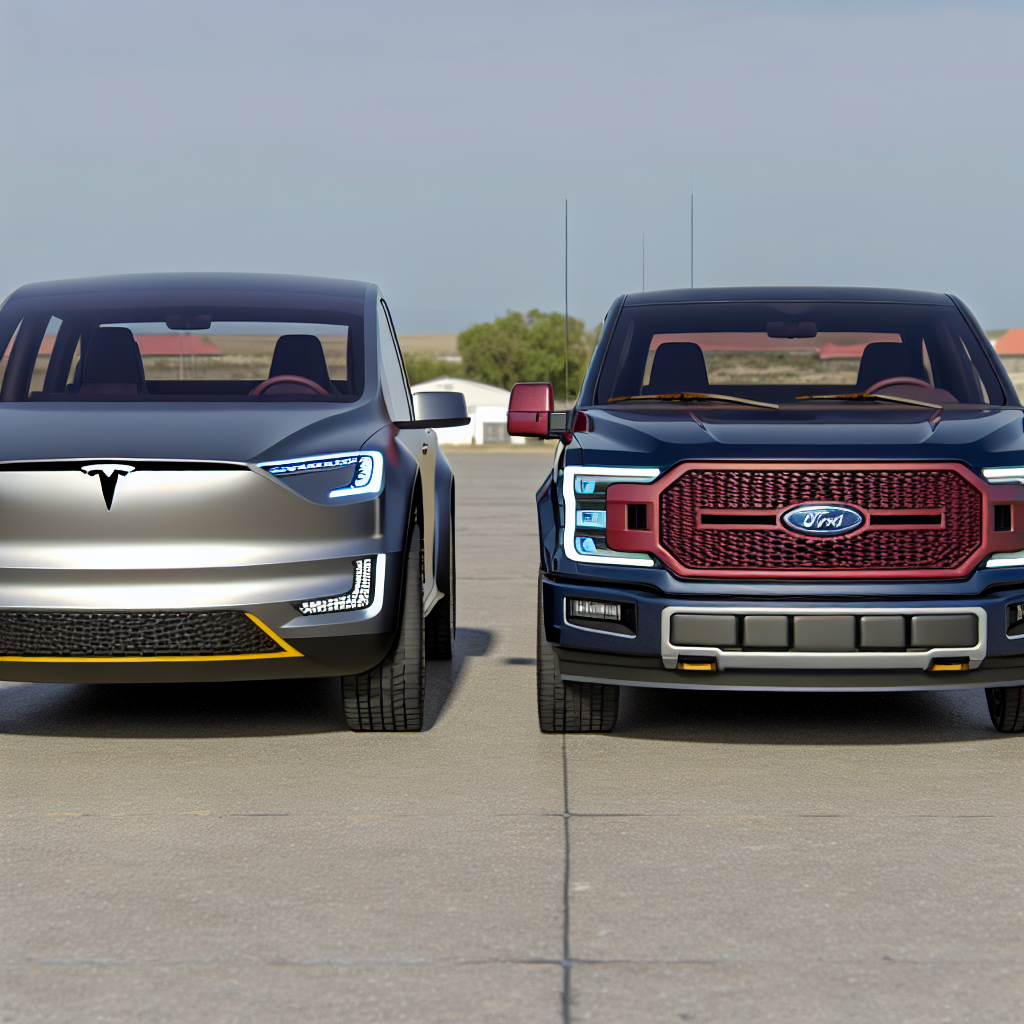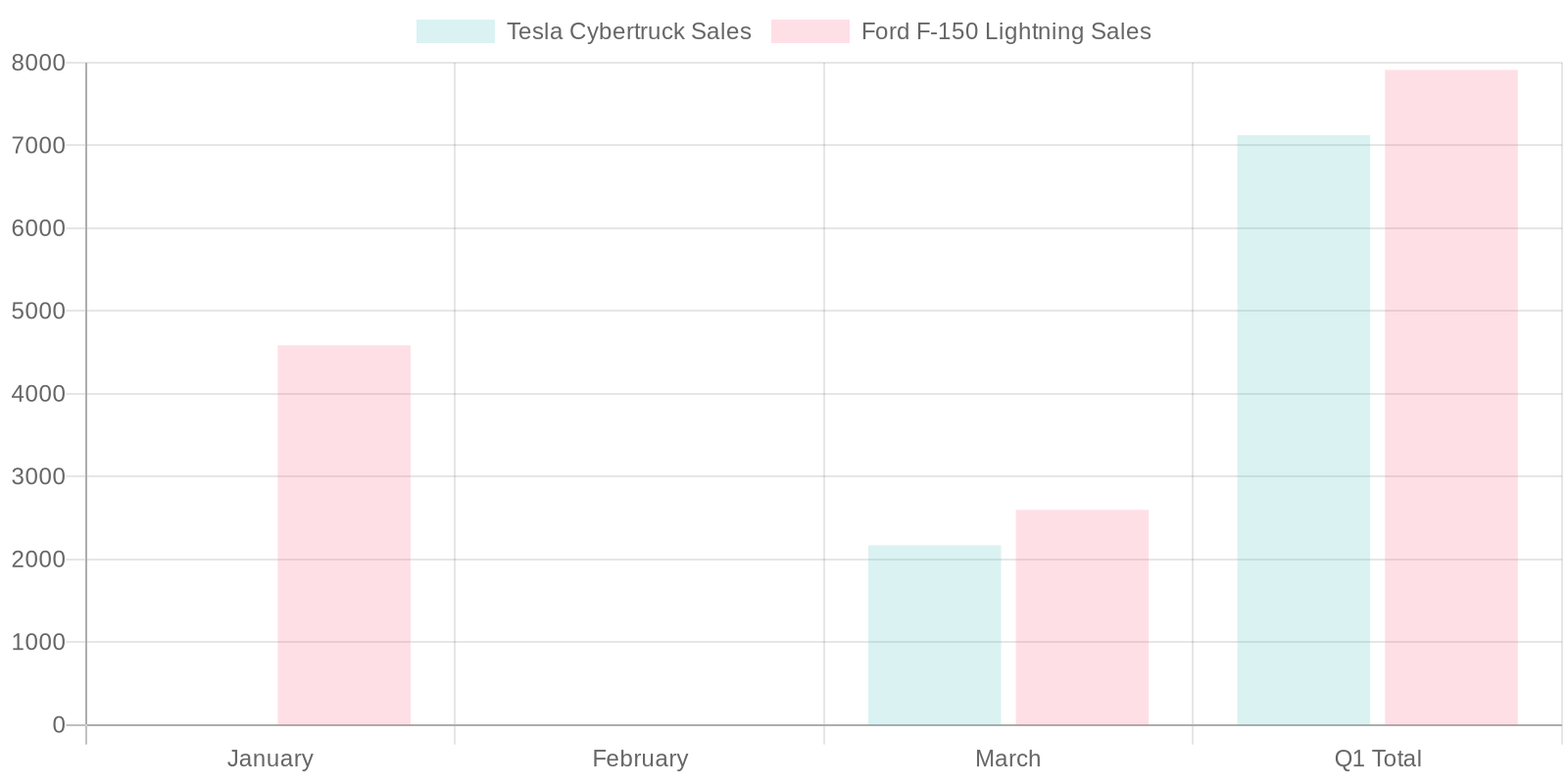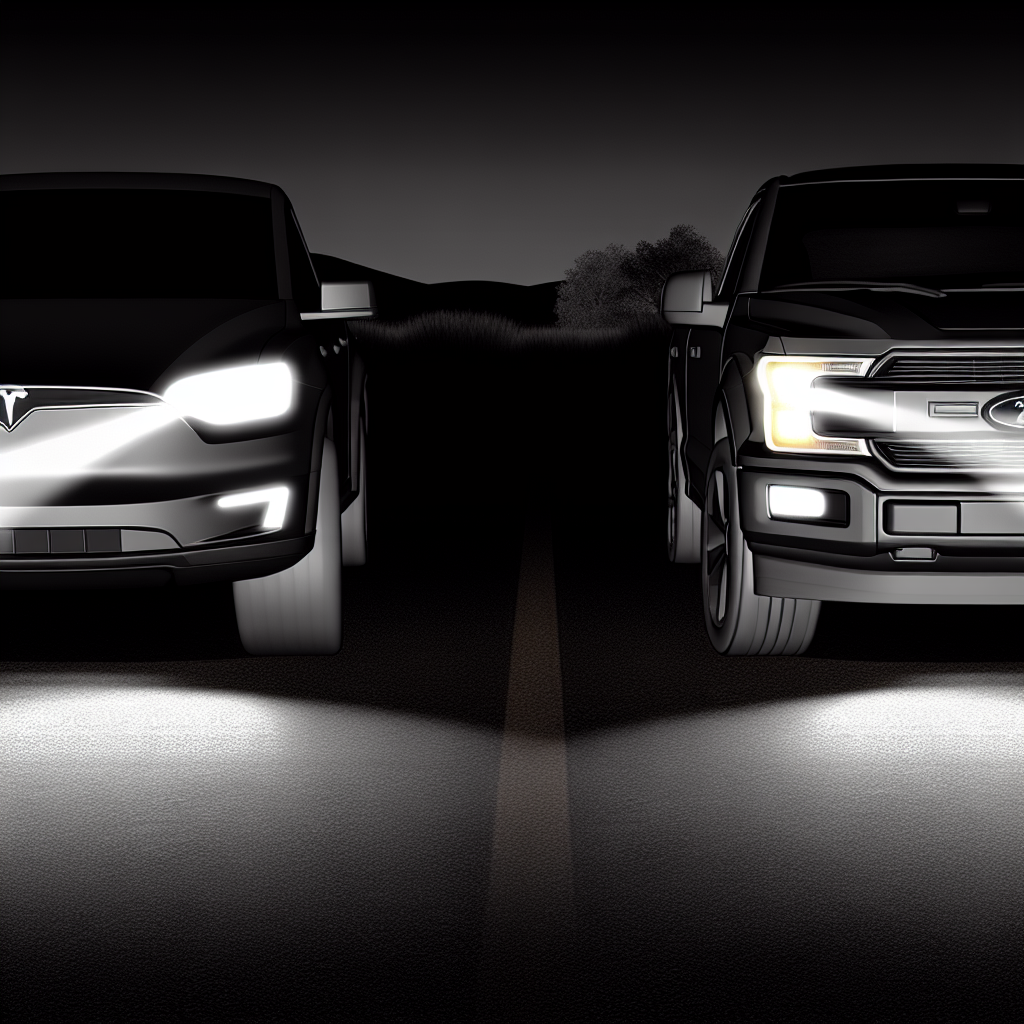As electric vehicles gain traction in a market that continuously evolves, the importance of safety ratings cannot be overstated. The recent crash test results published by the Insurance Institute for Highway Safety (IIHS) for the Tesla Cybertruck and Ford F-150 Lightning highlight this very significance. These ratings not only offer insights into the crashworthiness of these innovative trucks but also play a vital role in shaping consumer perceptions and influencing purchasing decisions.
In a landscape where safety is paramount, understanding how these two electric models perform under stringent testing conditions could very well tip the scales in favor of one over the other. As potential buyers evaluate their options, the ramifications of these safety evaluations become clear: in the pursuit of innovation and sustainability, vehicle safety remains a non-negotiable pillar that can determine market success.
| Feature | Tesla Cybertruck | Ford F-150 Lightning |
|---|---|---|
| Overall Safety Rating | Good | Poor |
| Headlight Rating | Poor (excessive glare) | Acceptable |
| Rear Passenger Safety | Moderate risk of injuries | High risk of injuries |
| Airbag Deployment | Good | Issues with deployment |
| Crash Avoidance | Good | Good |
| Crash Test Performance | Strong for front/rear | Concerns for rear |
| Child Seat Anchor Ease | Better | Average |
Analysis of Safety Features of Tesla Cybertruck and Ford F-150 Lightning
The IIHS Crash Test Results show important differences in the safety features of the Tesla Cybertruck and Ford F-150 Lightning. Consumers should pay attention to these differences concerning crashworthiness, headlight performance, and ease of using child seat anchors.
Crashworthiness
The IIHS tested both vehicles using several crash tests, including the moderate overlap front crash test. The Tesla Cybertruck received a “Good” rating, especially in frontal crash situations. This is thanks to design improvements made after April 2025 that aimed to protect occupants during collisions.
On the other hand, the Ford F-150 Lightning scored a “Poor” rating in the same tests. Despite having a structure rated as “Good”, the rear passenger safety raised concerns. This included risks for chest injuries and issues with seatbelts that could endanger occupant safety. Some believe that “…the F-150 Lightning, by virtue of being on the older T3 platform as the gas F-150s, may fare better once it gets a redesign.”
Headlight Performance
In terms of headlight performance, the Cybertruck was rated “Poor” due to excessive glare. This glare could be a hazard for other drivers, especially during night driving conditions. Conversely, the F-150 Lightning received an “Acceptable” rating, although some visibility concerns still exist. This indicates room for improvement. It’s noteworthy that “…the agency didn’t criticize the headlights’ performance — visibility is typically good for the driver in most situations.”
Child Seat Anchors Ease of Use
Regarding child seat anchors, or LATCH (Lower Anchors and Tethers for Children), the Cybertruck received an “Acceptable” rating. This means it is reasonably user-friendly for parents. In contrast, the F-150 Lightning scored a “Marginal” rating, indicating that parents may find it more difficult to secure child seats.
Conclusion
In summary, the IIHS Crash Test Results show that the Cybertruck excels in crashworthiness. However, the F-150 Lightning performs better with headlights. Both vehicles have areas to improve, particularly with child seat anchor usability. Understanding these insights is crucial for consumers prioritizing safety features in their electric vehicle choices.
IIHS Crash Test Criteria Explained
The Insurance Institute for Highway Safety (IIHS) has clear criteria for vehicle safety ratings. Vehicles get rated as “Good,” “Acceptable,” “Marginal,” or “Poor” based on their crashworthiness and crash avoidance features.
Crashworthiness Ratings
- Moderate Overlap Front Test: This test checks how well a vehicle handles a frontal collision where 40% of its width hits a barrier at 40 mph. A “Good” rating indicates strong structure and low injury risk.
- Small Overlap Front Test: This simulates a crash where 25% of the front strikes a barrier. The ratings reflect how well the vehicle protects occupants in this scenario.
- Side Impact Test: This evaluates how well a vehicle protects against side collisions. Ratings focus on head protection and injury measures.
- Headlight Evaluation: This measures the car’s headlights’ effectiveness, rating them based on visibility without excessive glare.
- Front Crash Prevention: This assesses the effectiveness of automatic emergency braking systems in avoiding crashes with vehicles and pedestrians.
Performance of Tesla Cybertruck and Ford F-150 Lightning
- Tesla Cybertruck:
- Rating: Good in the Moderate Overlap Front Test, showing strong occupant protection due to design improvements made after April 2025.
- Received a Poor rating in Headlight Evaluation for excessive glare, impairing visibility for other drivers.
- Earned a Good rating in Front Crash Prevention, effectively avoiding collisions in tested scenarios.
- Ford F-150 Lightning:
- Rating: Poor in the Moderate Overlap Front Test, revealing weaknesses concerning rear-seat safety and high risks of chest and neck injuries for rear passengers.
- Rated Acceptable for Headlight Evaluation, indicating reasonable illumination but some visibility issues.
- Achieved a Good rating in Front Crash Prevention, successfully avoiding pedestrian collisions.
The IIHS results highlight key differences between these two vehicles. The Cybertruck excels in crashworthiness but struggles with headlight performance. Meanwhile, the F-150 Lightning faces serious concerns regarding rear occupant safety despite having better headlight visibility than the Cybertruck.

As of early 2025, the market reception for the Tesla Cybertruck and Ford F-150 Lightning has showcased distinct user adoption patterns reflective of consumer priorities, particularly regarding safety and design. In the first quarter of 2025, the Ford F-150 Lightning reclaimed its status as the best-selling electric pickup truck in the United States, with sales reaching 7,913 units, surpassing the 7,126 units sold by the Tesla Cybertruck. In 2024, the Cybertruck led the market with total sales of 38,965 units; however, by March 2025, its popularity waned, causing it to slip from the top ten electric vehicle registrations.
Safety issues have emerged as a significant factor affecting consumer perception of the Cybertruck, which has faced multiple recalls, including a notable incident involving 46,096 vehicles due to a detachable exterior panel, raising concerns about its overall reliability. On the other hand, the Ford F-150 Lightning has resonated more favorably with traditional truck buyers due to its conventional styling and competitive pricing, which have played crucial roles in sustaining robust sales figures.
Consequently, the Cybertruck’s unconventional aesthetics have evoked mixed responses, coupled with safety criticisms, while the F-150 Lightning’s alignment with consumer expectations solidifies its strong foothold in the marketplace.
The impact of visibility on user adoption is significant, as potential buyers often prioritize safety features, particularly the effectiveness of headlights in real-world driving conditions. This insight highlights the delicate balance between innovative design and functional safety that can sway user preferences from one model to another.
IIHS Crash Test Criteria Explained
The Insurance Institute for Highway Safety (IIHS) has established a rigorous set of criteria to evaluate vehicle safety through its crash test ratings. Vehicles are rated as “Good,” “Acceptable,” “Marginal,” or “Poor” based on their performance during various evaluations that assess both crashworthiness and crash avoidance features.
Crashworthiness Ratings
- Moderate Overlap Front Test: This assesses the vehicle’s performance in a frontal collision where 40% of its width strikes a barrier at a speed of 40 mph. A rating of “Good” suggests strong structural integrity and a low risk of injury to occupants. In contrast, a “Poor” rating indicates significant structural weaknesses and a high risk of injury.
- Small Overlap Front Test: This simulates a crash where 25% of the vehicle’s front strikes a barrier, concentrating forces in a narrower area. The ratings reflect how well the vehicle protects occupants in this kind of impact.
- Side Impact Test: Evaluates how well the vehicle protects occupants from side collisions, with ratings focused on head protection and injury measures.
- Headlight Evaluation: This assessment measures the effectiveness of a vehicle’s headlights, rating them from “Good” to “Poor” based on visibility without excessive glare to oncoming drivers.
- Front Crash Prevention: Evaluates automatic emergency braking systems’ effectiveness in avoiding or mitigating frontal crashes with vehicles and pedestrians.
Performance of Tesla Cybertruck and Ford F-150 Lightning
-
Tesla Cybertruck:
- Rating: Good in the Moderate Overlap Front Test, reflecting strong occupant protection, especially for front and rear occupants due to structural enhancements made in models after April 2025.
- In Headlight Evaluation, the Cybertruck received a Poor rating for excessive glare, which can impair visibility for other drivers.
- The vehicle earned a Good rating in Front Crash Prevention, effectively avoiding collisions in tests simulated for both pedestrians and vehicles.
-
Ford F-150 Lightning:
- Rating: Poor in the Moderate Overlap Front Test, with tests revealing weaknesses in rear-seat safety, including high risks of chest and neck injuries for rear passengers. Seat belt positioning issues further increased injury risk.
- The F-150 Lightning received an Acceptable rating in Headlight Evaluation, indicating reasonable illumination but with some visibility limitations.
- For Front Crash Prevention, it achieved a Good rating, successfully avoiding pedestrian collisions across various scenarios.
These results from the IIHS illustrate critical differences between the Tesla Cybertruck and Ford F-150 Lightning. While the Cybertruck excels in crashworthiness, it does have limitations in headlight performance. In comparison, the F-150 Lightning has significant rear occupant safety concerns, despite performing better in headlight visibility than the Cybertruck.
Analytical Comparison of Market Positions: Tesla Cybertruck, Ford F-150 Lightning, and Rivian R1T
As of October 2025, the competition in the electric pickup truck market is heating up, with key players like Tesla’s Cybertruck, Ford’s F-150 Lightning, and Rivian’s R1T vying for consumer attention. Each vehicle presents unique market strengths and weaknesses, particularly concerning safety features and overall performance.
Sales Performance
Sales figures reveal a keen competition between the leading models:
- Ford F-150 Lightning: In the first quarter of 2025, Ford recorded 7,913 sales, making it the best-selling electric pickup truck. Its established reputation as a traditional truck has appealed significantly to buyers transitioning to electric options.
- Tesla Cybertruck: Tesla’s Cybertruck, with 7,126 sales in Q1 2025, showed a decline compared to the previous quarter’s 9,000. Its unconventional aesthetics and associated safety recalls might have impacted consumer interest.
- Rivian R1T: Rivian reported 1,600 vehicle registrations during the same timeframe, reflecting a 33% decrease. While Rivian’s innovative features initially attracted early adopters, ongoing production challenges have affected sales stability.
Safety Ratings and Implications
Safety is paramount in influencing purchase decisions, and each vehicle’s safety ratings vary significantly:
- Tesla Cybertruck: The Cybertruck achieved a 5-star overall safety rating from NHTSA. It excelled in many categories; however, it received a 4-star rating for rollover risk, indicating that while it is robust, there are still concerns for high-center-of-gravity vehicles.
- Ford F-150 Lightning: The Lightning also received a 5-star safety rating but faced similar issues with rollover resistance and frontal crash performance. Its sales performance suggests consumers are reassured by its safety credentials, despite minor caveats.
- Rivian R1T: Although the R1T has not been officially rated, it has fared well in tests conducted by the IIHS. However, the lack of a formal NHTSA evaluation leaves some uncertainty in its market positioning. Consumer perception of safety can significantly influence future sales.
Future Implications
Market trends show an increasing demand for electric pickups with a focus on safety and reliability. Ford’s established market position, combined with a strong safety reputation, positions the Lightning for sustained sales growth. On the other hand, Tesla must address consumer concerns surrounding the Cybertruck’s safety record and improve its public image to regain its market lead. Rivian, while facing challenges, can capitalize on its positive safety evaluations if it boosts production reliability and fills its production pipeline.
Overall, as the electric vehicle market evolves, the emphasis on safety and consumer trust will play critical roles in shaping the future trajectories of these electric trucks. Continuous improvements in safety technology and consumer education will be vital in influencing buyers’ choices and shaping the competitive landscape.
In conclusion, the IIHS Crash Test Results significantly affect consumer purchasing decisions regarding the Tesla Cybertruck and Ford F-150 Lightning, highlighting the paramount importance of safety in the evolving electric vehicle market.
The Cybertruck, with its strong performance in crashworthiness tests, positions itself as a favorable option for safety-conscious consumers. However, concerns about visibility and headlight glare remain, which could influence buyer preferences.
In contrast, the Ford F-150 Lightning’s disappointing safety ratings raise questions about its overall reliability and occupant protection, particularly for rear passengers.
As safety ratings become a critical factor in consumer decisions, it is imperative for potential buyers to thoroughly consider these evaluations when selecting an electric vehicle. Prioritizing safety not only safeguards occupants but also builds confidence in the rapidly growing electric vehicle landscape.
Make informed choices and let safety guide your decisions when exploring the exciting world of electric trucks!


This graph represents the sales performance trends for the Tesla Cybertruck and Ford F-150 Lightning in the first quarter of 2025, illustrating the competitive dynamics between both models.
Key Insights:
- The Ford F-150 Lightning achieved higher sales compared to the Tesla Cybertruck in Q1 2025.
- In March 2025, the Cybertruck sold 2,170 units, whereas the F-150 Lightning recorded 2,598 units.
- Overall, the F-150 Lightning led with 7,913 units sold in Q1, indicating stronger consumer preference during this period.
- The decline in Cybertruck sales compared to previous quarters highlights potential impacts from safety concerns and recalls, whereas the Lightning benefited from Ford’s established reputation and incentives.
As electric vehicles gain traction in a market that continuously evolves, the importance of safety ratings cannot be overstated. The recent crash test results published by the Insurance Institute for Highway Safety (IIHS) for the Tesla Cybertruck and Ford F-150 Lightning highlight this very significance. These ratings not only offer insights into the crashworthiness of these innovative trucks but also play a vital role in shaping consumer perceptions and influencing purchasing decisions. In a landscape where safety is paramount, understanding how these two electric models perform under stringent testing conditions could very well tip the scales in favor of one over the other. As potential buyers evaluate their options, the ramifications of these safety evaluations, particularly electric truck safety ratings, become clear: in the pursuit of innovation and sustainability, vehicle safety remains a non-negotiable pillar that can determine market success.
Crash Test Comparison
| Feature | Tesla Cybertruck | Ford F-150 Lightning |
|---|---|---|
| Overall Safety Rating | Good | Poor |
| Headlight Rating | Poor (excessive glare) | Acceptable |
| Rear Passenger Safety | Moderate risk of injuries | High risk of injuries |
| Airbag Deployment | Good | Issues with deployment |
| Crash Avoidance | Good | Good |
| Crash Test Performance | Strong for front/rear | Concerns for rear |
| Child Seat Anchor Ease | Better | Average |
Analysis of Safety Features of Tesla Cybertruck and Ford F-150 Lightning
The IIHS Crash Test Results show important differences in the safety features of the Tesla Cybertruck and Ford F-150 Lightning. Consumers should pay attention to these differences concerning crashworthiness, headlight performance, and ease of using child seat anchors.
Crashworthiness
The IIHS tested both vehicles using several crash tests, including the moderate overlap front crash test. The Tesla Cybertruck received a “Good” rating, especially in frontal crash situations. This is thanks to design improvements made after April 2025 that aimed to protect occupants during collisions.
On the other hand, the Ford F-150 Lightning scored a “Poor” rating in the same tests. Despite having a structure rated as “Good”, the rear passenger safety raised concerns. This included risks for chest injuries and issues with seatbelts that could endanger occupant safety. Some believe that “…the F-150 Lightning, by virtue of being on the older T3 platform as the gas F-150s, may fare better once it gets a redesign.”
Headlight Performance
In terms of headlight performance, the Cybertruck was rated “Poor” due to excessive glare. This glare could be a hazard for other drivers, especially during night driving conditions. Conversely, the F-150 Lightning received an “Acceptable” rating, although some visibility concerns still exist. This indicates room for improvement. It’s noteworthy that “…the agency didn’t criticize the headlights’ performance — visibility is typically good for the driver in most situations.”
Child Seat Anchors Ease of Use
Regarding child seat anchors, or LATCH (Lower Anchors and Tethers for Children), the Cybertruck received an “Acceptable” rating. This means it is reasonably user-friendly for parents. In contrast, the F-150 Lightning scored a “Marginal” rating, indicating that parents may find it more difficult to secure child seats.
Conclusion
In summary, the IIHS Crash Test Results show that the Cybertruck excels in crashworthiness. However, the F-150 Lightning performs better with headlights. Both vehicles have areas to improve, particularly with child seat anchor usability. Understanding these insights is crucial for consumers prioritizing safety features in their electric vehicle choices, especially in the context of a Tesla Cybertruck comparison and Ford F-150 Lightning reviews.
IIHS Crash Test Criteria Explained
The Insurance Institute for Highway Safety (IIHS) has clear criteria for vehicle safety ratings. Vehicles get rated as “Good,” “Acceptable,” “Marginal,” or “Poor” based on their crashworthiness and crash avoidance features.
Crashworthiness Ratings
- Moderate Overlap Front Test: This test checks how well a vehicle handles a frontal collision where 40% of its width hits a barrier at 40 mph. A “Good” rating indicates strong structure and low injury risk.
- Small Overlap Front Test: This simulates a crash where 25% of the front strikes a barrier. The ratings reflect how well the vehicle protects occupants in this scenario.
- Side Impact Test: This evaluates how well a vehicle protects against side collisions. Ratings focus on head protection and injury measures.
- Headlight Evaluation: This measures the car’s headlights’ effectiveness, rating them based on visibility without excessive glare.
- Front Crash Prevention: This assesses the effectiveness of automatic emergency braking systems in avoiding crashes with vehicles and pedestrians.
Performance of Tesla Cybertruck and Ford F-150 Lightning
- Tesla Cybertruck:
- Rating: Good in the Moderate Overlap Front Test, showing strong occupant protection due to design improvements made after April 2025.
- Received a Poor rating in Headlight Evaluation for excessive glare, impairing visibility for other drivers.
- Earned a Good rating in Front Crash Prevention, effectively avoiding collisions in tested scenarios.
- Ford F-150 Lightning:
- Rating: Poor in the Moderate Overlap Front Test, revealing weaknesses concerning rear-seat safety and high risks of chest and neck injuries for rear passengers.
- Rated Acceptable for Headlight Evaluation, indicating reasonable illumination but some visibility issues.
- Achieved a Good rating in Front Crash Prevention, successfully avoiding pedestrian collisions.
The IIHS results highlight key differences between these two vehicles. The Cybertruck excels in crashworthiness but struggles with headlight performance. Meanwhile, the F-150 Lightning faces serious concerns regarding rear occupant safety despite having better headlight visibility than the Cybertruck.
User Adoption Data Summary
As of early 2025, the market reception for the Tesla Cybertruck and Ford F-150 Lightning has showcased distinct user adoption patterns reflective of consumer priorities, particularly regarding safety and design. In the first quarter of 2025, the Ford F-150 Lightning reclaimed its status as the best-selling electric pickup truck in the United States, with sales reaching 7,913 units, surpassing the 7,126 units sold by the Tesla Cybertruck.
In 2024, the Cybertruck led the market with total sales of 38,965 units; however, by March 2025, its popularity waned, causing it to slip from the top ten electric vehicle registrations. Electric truck safety ratings have emerged as a significant factor affecting consumer perception of the Cybertruck, which has faced multiple recalls, including a notable incident involving 46,096 vehicles due to a detachable exterior panel, raising concerns about its overall reliability.
On the other hand, the Ford F-150 Lightning has resonated more favorably with traditional truck buyers due to its conventional styling and competitive pricing, which have played crucial roles in sustaining robust sales figures. Consequently, the Cybertruck’s unconventional aesthetics have evoked mixed responses, coupled with safety criticisms, while the F-150 Lightning’s alignment with consumer expectations solidifies its strong foothold in the marketplace.
The impact of visibility on user adoption is significant, as potential buyers often prioritize safety features, particularly the effectiveness of headlights in real-world driving conditions. This insight highlights the delicate balance between innovative design and functional safety that can sway user preferences from one model to another.

